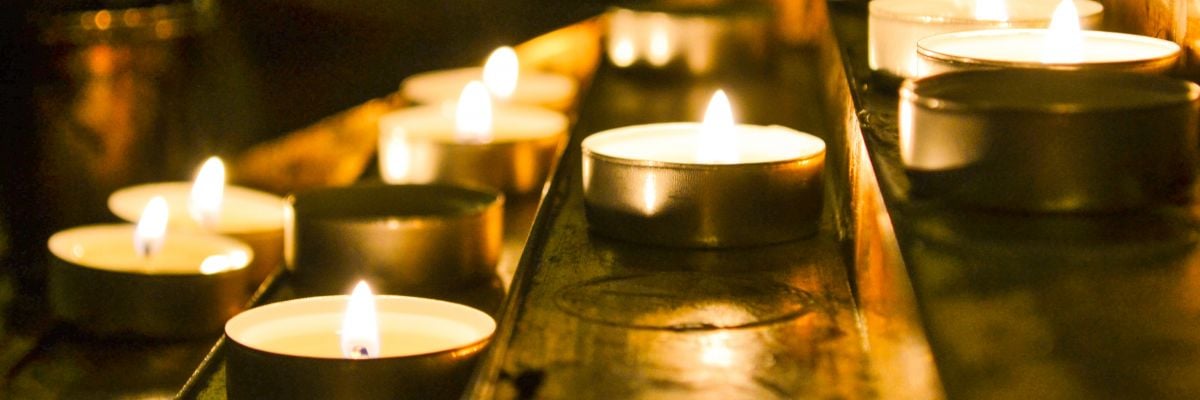
In the movie Cromwell, Richard Harris played the Lord Protector, the leading character. In one scene Cromwell went into a rage.
The Puritans had recently succeeded in having churches “cleansed” of the last of their Papist accretions. One Sunday, Cromwell sat in his pew and saw light flickering on the altar. He stomped into the sanctuary, interrupted the preacher, and smashed the candlesticks which had been reintroduced into the service.
Accusations of paganism and superstition have been made by anti-Catholics for generations. The Church has been criticized for its use of symbols and externals, such as candles, in its worship. Why does the Catholic Church make use of the lighted candle, particularly the beeswax candle, in the Mass?
Some symbols can be considered universal because they have been used and accepted so widely and for so long. They are found among nearly all societies in all ages. They form a natural language of mystical expression. The use of light in religious ceremonies is one of these.
Light, as the New Catholic Encyclopedia notes, signifies “joy, optimism, goodness, purity, beauty, festiveness, dignity and life. It is opposed to darkness, which signifies sadness, gloom, desolation, death, ignorance, error, and evil in general.” Christians also find in light the symbol of “truth, faith, wisdom, virtue, grace, divine life, charity, ardor of prayer, sacred presence and the beatific vision.”
Light is created by God. “Then God said ‘Let there be light,’ and there was light. God saw how good the light was” (Gen. 1:3-4). God manifests himself in the burning bush (Ex. 3:2). He dwells in unapproachable light (1 Tim. 6:16). He is light and in him there is no darkness (1 John 1:5). The Holy of Holies is lighted with the seven-branched candle stand (Lev. 24:2-4).
The early Church saw light in use in pagan rites. Lamps, candles, and fires were used to venerate the gods, the dead, and the emperor. The use was so pervasive that the Church was inhibited in using candles in its own rites. Christians attempted to avoid confusion and syncretism by confining candles to the practical matter of household illumination.
With the gradual ascendancy of the Church and the disappearance of paganism, the danger of pagan connotations subsided. Once the Church saw no danger in the use of light in worship, it saw the immense appropriateness of it.
We find that by Jerome’s time, “In all the churches of the East lights are lit when the Gospel is to be read, even though the sun be rising, but the purpose is not to dispel the darkness but to give a visible sign of joy.” When the meaning of the beeswax candle was pondered, particularly in the Middle Ages, a rich and detailed symbolism emerged. Christ had declared, “I am the light of the world” (John 9:5), and the candle’s light came to be the symbol for his presence.
The pale wax of the candle symbolizes Christ’s flesh, his sacred humanity. The wick, embedded in the center of the candle, represents his soul. The flame, as it burns down the wick, consumes the wax to give us light. It burns, expending itself, sacrificing itself, just as Christ sacrificed himself. The burning candle is aesthetically pleasing, and it gives a sweet aroma as it burns, another reminder of the presence of our Lord.
Realizing the value of the candle in its worship, the Church prescribes that candles be lit for Mass. They must be at least 51% beeswax.
The wax produced by the honeybee is considered the sweetest and purist, the most appropriate for symbolizing the humanity of Christ.
It is produced by the bees actually consuming honey (honey itself is a symbol for the superlative in sweetness, the sweetness of the Word of God). Christ identifies himself as the Light of the World and he says in Luke 12:49, “I have come to light a fire on the Earth. How I wish the blaze were ignited!” A flame will spread to what it touches.
The candle also symbolizes Christ’s presence in the individual believer. The Easter Vigil shows this when the new flame is lit, blessed, and touched to the tapers held by members of the congregation, The light spreads from one to the next.
The newly baptized, the newly ordained, and the newly professed are given candles, and votive candles stand in for the believer at prayer. On the other hand, the extinguishing of a candle is found in ritual excommunication.
A critic of candles in the Church reveals in himself a simplistic or puritanical mindset. The widespread use of light in worship reflects a truly human appreciation for the appropriateness of the symbol. The inability of someone to perceive this reveals a kind of blindness.
What can we do with people who argue against the use of such externals? First, educate them; then, light a candle for them!


